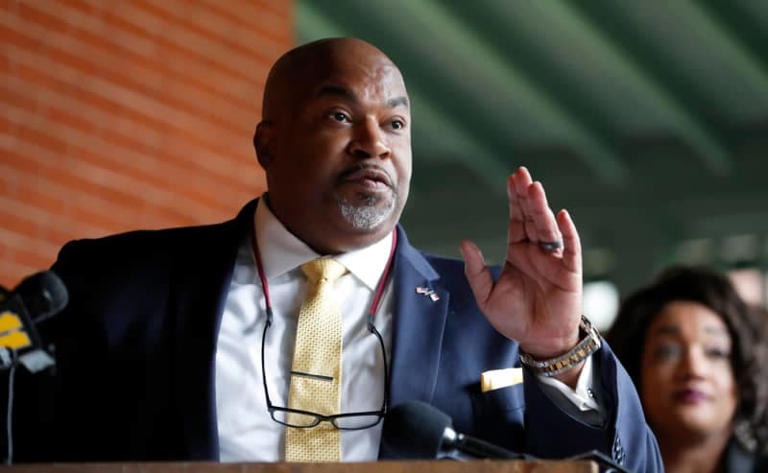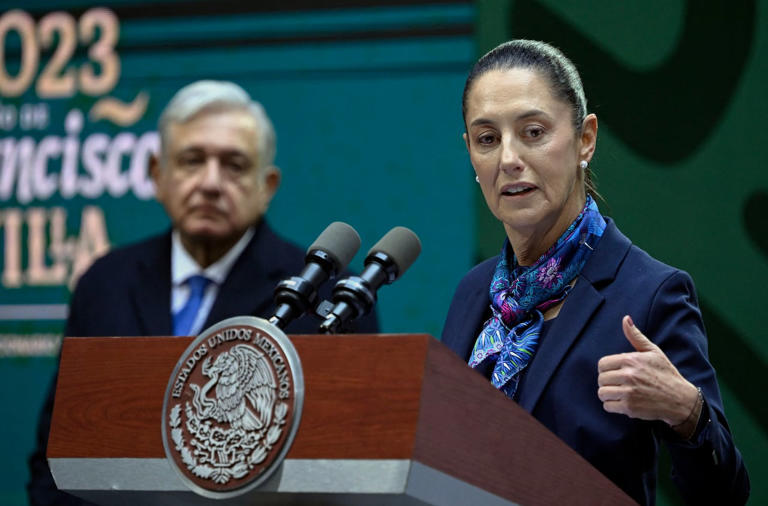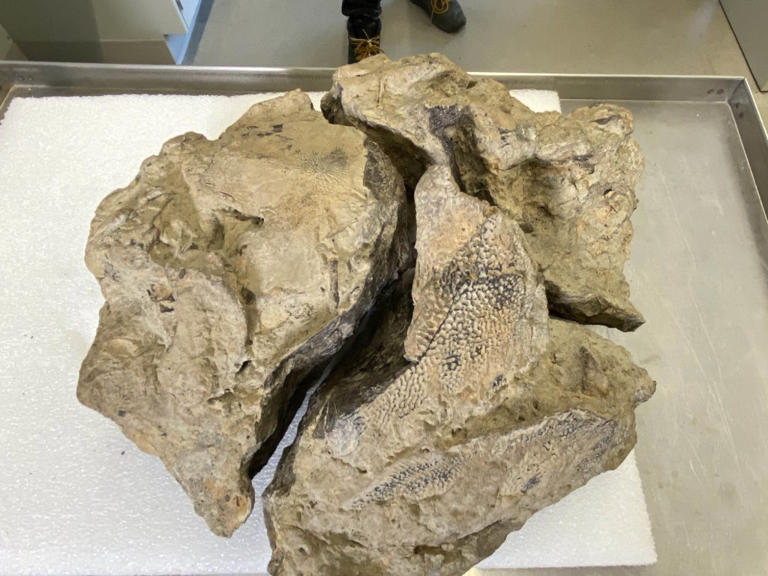
Mark Robinson speaks during a press conference in Raleigh on Tuesday, March 16, 2021. - Ethan Hyman/The News & Observer/TNS© provided by RawStory
North Carolina's election-denying lieutenant governor met privately with Ginni Thomas, the right-wing conspiracy theorist and wife of Supreme Court justice Clarence Thomas, shortly before declaring that President Joe Biden "stole the election."
Lt. Gov. Mark Robinson, now the frontrunner in the state's Republican gubernatorial primary, took part in a private meeting with Thomas weeks after the Jan. 6 insurrection, according to a copy of his official schedule produced through a Freedom of Information Act request by The Daily Beast.
It's not clear what the pair discussed in their March 30, 2021, meeting or who else participated, but the lieutenant governor's calendar note indicates that he met with Thomas and the Frontliners for Liberty group that she runs.
Frontliners for Liberty initially started out as a Facebook group that described itself as a "liberty-focused, action-oriented group of state leaders representing grassroots armies," but it eventually transformed into a nexus for right-wing activists trying to keep Donald Trump in power – even after the vanquished ex-president left office.
ALSO READ: Birtherism is back. But these top GOPers are tired of Trump’s citizenship conspiracies.
The House Select Committee investigated Thomas' group as part of its sprawling Jan. 6 probe and found that Trump attorney John Eastman spoke to the group in December 2020 at her invitation about “state legislative actions that can reverse the media-called election for Joe Biden," according to a meeting agenda obtained through a court order.
Related video: Former judge: ‘Clarence Thomas will recuse himself when Ginni flies’ (MSNBC) Duration 3:06 View on Watch
Thomas emailed dozens of state legislators in both Arizona and Wisconsin in November and December 2020 urging them to set aside Biden's election win and choose their own electors for Trump, according to communications obtained by watchdog groups and media organizations.
The Frontliners group continued their efforts to undermine Biden's election win for at least two months after his inauguration, including a gathering three weeks before Thomas' meeting with Robinson that featured a speech by conservative pundit C.L. Bryant.
“There is a robbery that is going on in this country right now,” Bryant said, according to a Washington Post report on the March 6, 2021, meeting. “In fact, I say it to you and I’ll say it loud and clear, and I’m not ashamed to say it. I won’t bite my tongue. I do believe that Donald John Trump is the only legitimate president.”
Sky Palma
October 25, 2023

(Anthony Crider/Flickr)
Lieutenant governor of North Carolina and a leading Republican candidate for governor, Mark Robinson, quoted Hitler and downplayed the Holocaust in an unearthed Facebook post, according to a new report.
Robinson has a long history of regurgitating antisemitic conspiracy theories and downplaying of the Holocaust, according to Jewish Insider. But at a press conference two weeks ago, he denied that he is antisemitic.
Robinson said his past social media posts had been dealt with and he had "moved past" them.
But he has been hit with new accusations that, in a Facebook post, he quoted Hitler and suggested the horror of the Holocaust wasn't as bad as the abuses of communism. He also compared the removal of Confederate statues to anti-Jewish pogroms in 1930s Europe, the Jewish Insider reported.
“We often speak of the 'appeasement’ of Hitler. But the biggest ‘appeasement’ of ALL TIME is how we turned a blind eye to the clear and present danger of MARXISM,” Robinson said in a post from 2019.
“It is EXTREMELY distressing that many well-meaning and intelligent people are so focused on long dead Hitler while the living political descendants of Stalin are currently fighting to destroy our REPUBLIC,” he wrote in a separate post days earlier.
Some GOP activists are worried that the discovery of more comments will hurt Robinson's chances of winning the governor race.
"The lieutenant governor, whom polls show as the front-runner, is now facing five Republican primary challengers, including Bill Graham, a wealthy trial lawyer who announced his campaign last week, vowing to spend millions of his own money," Jewish Insider reported. "The winner is expected to face off against a Jewish Democrat, Josh Stein, who is the state’s attorney general. Gov. Roy Cooper, a Democrat, is term-limited."
Read the full report over at Jewish Insider.
The GOP candidate who believes Beyoncé is 'Satanic' and America is ruled by lizard people
Matthew Chapman
August 22, 2023 9:05AM ET

(AFP)
Far-right North Carolina Lt. Gov. Mark Robinson, the Republican frontrunner to become the state's governor, has far more extreme conspiracy theory beliefs than were previously known, the Huffington Post revealed this week.
According to the report, Robinson has pushed a number of bizarre theories on Facebook, including that the music industry is controlled by Satan. He claimed that Beyoncé's songs sound like "Satanic chants" and that, "Her songs sound like they say stuff like 'satan laughs as you rot in hell' if play them backwards. SUPER WEIRD!!!!!"
He also claimed that Jay-Z is a "demonic stooge of Satan" who pledged to lead "as many people as possible" away from Jesus in exchange for fortune and fame," according to the report.
But that isn't even the end of it, Huffington Post reported.
Robinson has also claimed that the 2014 kidnapping of Nigerian schoolgirls by terror group Boko Haram was orchestrated by billionaire philanthropist George Soros — a frequent target of anti-Semitic conspiracy theories. And he has on multiple occasions backed not just the extremist QAnon movement, which believes that America is controlled by Satanic pedophiles, but also the "New World Order" theory, which claims that the world will be subject to forced depopulation by a secret order of lizard people who are trying to impose the Biblical end times on civilization.
This comes after a number of other extreme beliefs by Robinson have come to light, including a vehement hatred of LGBTQ people, the idea the survivors of the Parkland school shooting sold their souls to the devil for fame, and the belief that children below fifth grade should not be taught science and history.
Republican consultants are reportedly fearful that Robinson could become a serious liability for their efforts to retake the governorship of North Carolina, which has been held by Democrats for two terms under Roy Cooper. Democratic Attorney General Josh Stein is currently the leading candidate for governor on the Democratic side.



















